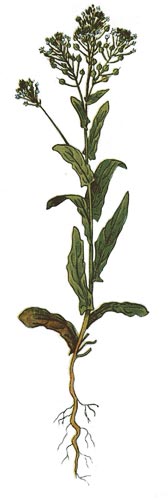Weeds
Cardaria draba (L.) Desv. - Heart-Podded Hoary Cress
Systematic position.
Family Brassicaceae Burnett (Cruciferae Juss.), genus Cardaria Desv.Synonyms.
Lepidium draba L.Biological group.
Perennial weed that forms rootstocks.Morphology and biology.
Plant is up to 50 cm tall, shortly pubescent. Root system is well-developed, consists of main tap root which reaches a depth of 1.5-2 m, and lateral roots that grow as long as 20-35 m which produce up to 1000 adventitious buds that produce new above-ground shoots. Lower leaves are petiolate, entire, lyrate or sinuate. Upper leaves are sessile with cordate or slightly sagittate base, ovate-oblong, often serrate-sinuate. Flowers are small, white, with petals up to 3 mm long; sepals are glabrous, with wide filmy margin, half the length of the petals. Fruit is silicle, obcordate, with prominent innervation on valves and with long style. Seeds are ovate or obovoid, with slightly visible wide rootlet along the edge; rootlet is a little shorter than cotyledons. Seed surface is covered with small knobs, lusterless, dark-brown or cherry-red. This plant flowers in April-May, bears fruits in June-July. C. draba reproduces by seeds and also vegetative reproduction by rootstocks and root fragments. One plant produces 3000-5000 seeds, which lose their germination capacity for two years under natural conditions. The seeds germinate best from the soil surface or at depths down to 2-3 cm. Optimum temperature for seed germination is 15-20°C, minimum is 4-5°C, maximum is 30-35°C; seedlings appear most often in early autumn or early spring. Reproduction of C. draba by rootstocks occurs mainly in autumn, favored by loose and wet soil. One plant can produce up to 25 rootstocks. Root fragments also sprout well in moistened soil, their sprouting ability increases with their length and fragments with lengths of 5 cm or less do not sprout at all.Distribution.
This species is distributed throughout the south of the European part of the Former Soviet Union, the Caucasus, Central Asia, south of Western Siberia. General distribution includes: Atlantic and Middle Europe, Mediterranean, Asia Minor and it is an adventive plant in North America and North Africa.Ecology.
This is a light-requiring plant that is oppressed by shade from cultivated plants. C. draba is drought-resistant and has a pronounced period of dormancy. This plant prefers alkaline soils but also grows well on all types of soils with moderate moisture. Its seeds are mainly distributed by irrigation water and animal manure.Economic significance.
This is a weed that is resistant under low levels of agrotechnics and with the absence of crop rotations. C. draba infests all agricultural crops and spring crops especially suffer from weed infestation. As a ruderal plant it occurs along roads and railway banks, in settlements, waste places, oasis, along irrigation canals in irrigated zone. Seeds of C. draba can be used as a substitute for pepper because they contain glycoside sinigrine which dissociates into mustard-ethereal oil. Leaves contain ascorbic acid. C. draba serves as a source of pollen and nectar for many insects. Control measures include shallow plowing, deep autumn plowing, timely cultivation of fallows and tilling crops as weed seedlings emerge.Reference citations:
Keller B.A., ed. 1934. Weed plants of the USSR. V. 3. Leningrad: AN SSSR. 448 p. (In Russian)Komarov, V.L. & N.A. Bush, eds. 1939. Flora of the USSR. V. 8. Moscow-Leningrad: AN SSSR. 696 p. (In Russian)
Mordovets A.A. 1964. Heart-podded hoary cress (Cardaria draba (L.) Desv.) - dangerous agricultural weed in arid steppe. Botanicheskii zhurnal, 49(7): 1057-60. (In Russian)
Nikitin, V.V. 1983. Weed plants of the USSR flora. Leningrad: Nauka. 454 p. (In Russian)
Rubtsov N.I., ed. 1971. Wild useful plants of Crimea (short guide). Transactions of Nikitskii Botanical Garden. V. XLIX. Yalta: Nikitskii Botanical Garden. 280 p. (In Russian)


